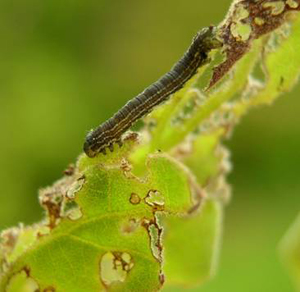DACF Home → Bureaus & Programs → Maine Forest Service → Forest Health & Monitoring → Forest Pest Index → Fall Cankerworm
FALL CANKERWORM
Alsophila pometaria (Harris)

Photo: Maine Forest Service, Forest Health & Monitoring, Photo Collection
Damage
This important pest of forest and shade trees occurs generally throughout most of Northeastern America where it feeds on a variety of hardwoods. Damage is first noticed in early May when feeding by the tiny larvae known as "cankerworms," "loopers," "inchworms" or "measuring worms" on the opening buds and expanding leaves causes the foliage to be skeletonized. Later as the larvae mature all but the midrib (and veins) of leaves are devoured.
Occasional outbreaks of this pest in Maine have caused severe defoliation of oak and elm. The outbreaks are most often localized and usually last three to four years before natural control factors cause the population to collapse. Trees subjected to two or more years of heavy defoliation may be seriously damaged, especially weaker trees or trees growing on poor sites.
Hosts
Its preferred hosts are oak, elm and apple, but it also occurs on maple, beech, ash, poplar, box elder, basswood, and cherry.
Description and Habits
The wingless, greyish-brown female cankerworm moths emerge from the duff with the onset of cold weather in October and November and crawl up the tree trunks. The male moth is greyish-brown with a one inch wing span. Males can often be seen flitting through infested stands during the day or warmer nights during hunting season. The females are not often seen. Females deposit their eggs in single-layered compact masses of 100 or more on the bark of smaller branches and twigs of trees often high in the crown from October to early December. The eggs are greyish-brown and neatly arranged in uniform rows. Hatching occurs in the spring as the buds begin to open, usually in late April or early May. The tiny larvae or cankerworms at first feed on the opening buds and young expanding leaves and cause the foliage to be skeletonized. As the cankerworms mature over the next five or six weeks, they devour all but the midrib (and veins) of leaves. Full grown cankerworms are about 1 inch long and vary in color from light green to brownish-green, with a darker stripe running down the middle of the back and a white stripe along each side. Larvae of this species have three pairs of fleshy legs near the end of the abdomen whereas most other species have only two. By mid- to late June, the cankerworms drop to the ground and pupate in the soil to reemerge in the fall as adult moths.
Two other species of cankerworms, inchworms or loopers which are also pests of hardwoods and apt to be confused with the fall cankerworm are the spring cankerworm, Paleacrita vernata (Peck) and Bruce spanworm, Operophtera bruceata (Hulst.). Like the fall cankerworm, the larval stage of these two is basically green to dark green or brownish, 3/4 to 1 inch long and move about with a looping motion. The spring cankerworm feeds principally on elm and maple and may be differentiated by its eggs, which are deposited in the spring in loose clusters on the bark of the trunk and larger branches, and by the number of abdominal legs (2 pair). Bruce spanworm, the smallest of the species, prefers maples and poplars and deposits eggs singly on the trunk and larger branches of host trees in late October and November. These eggs turn bright orange in color.
Control*
Control of this pest can be achieved by spraying the trees with a registered pesticide soon after the larvae first become active and after the leaves have become sufficiently expanded for coverage by the spray. Materials registered to control cankerworms in May or June include the following: carbaryl, acephate, fluvalinate and Bacillus thuringiensis (Bt), a microbial product. Be sure to refer to the pesticide label for specific use instructions.
In the past some attempts have been made to control infestations on shade trees by banding tree trunk with TREE Tanglefoot® or similar sticky material to prevent the adult females from crawling up trees to deposit their eggs. Since these sticky substances can soil or penetrate the bark and cause injury to the tree, the products should not be put directly on the bark but as a safety precaution should be applied by October on duct tape or similar material that can be wrapped in a band around the tree trunk.
*NOTE: These recommendations are not a substitute for pesticide labeling. Read the label before applying any pesticide. Pesticide recommendations are contingent on continued EPA and Maine Board of Pesticides Control registration and are subject to change.
Caution : For your own protection and that of the environment, apply the pesticide only in strict accordance with label directions and precautions.
MAINE DEPARTMENT OF AGRICULTURE, CONSERVATION AND FORESTRY
Maine Forest Service - Forest Health and Monitoring Division
April 2000